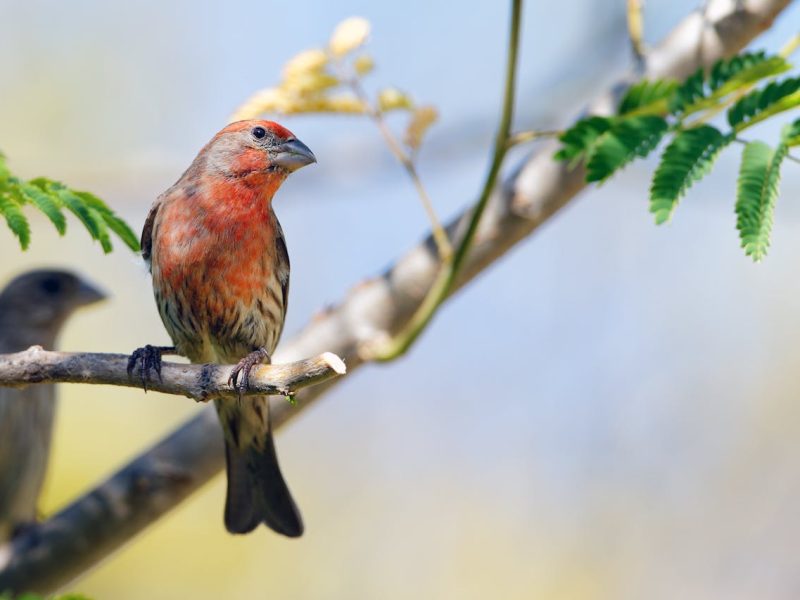Birds are incredibly fascinating creatures. From their ability to soar through the sky to their vibrant colors and intricate behaviors, they never fail to captivate us. As someone who loves observing nature, I’ve spent countless hours watching birds and marveling at their unique characteristics. In this article, we’ll explore some of the most intriguing facts about these winged wonders.
Birds’ Evolution and Ancestry
Dinosaur Connection
Did you know that birds are living dinosaurs? It might sound strange, but overwhelming scientific evidence suggests that birds evolved from feathered dinosaurs millions of years ago.
Researchers have discovered numerous fossils that link birds to their dinosaur ancestors, including the famous Archaeopteryx.
This ancient creature, which lived around 150 million years ago, had a combination of bird-like and reptilian features. It possessed feathers and wings, yet retained characteristics like teeth and a long, bony tail.
These transitional species provide a remarkable glimpse into the evolutionary journey that gave rise to modern birds.
Earliest Known Birds
Archaeopteryx is widely regarded as one of the earliest known birds, but it’s not the only ancient avian fossil that has been unearthed. In recent years, paleontologists have discovered other early bird fossils, such as Confuciusornis and Microraptor, which offer insights into the diversity and adaptations of these prehistoric creatures.
These early birds exhibited a range of features, from long feathers likely used for display to specialized beaks and teeth adapted for different diets. Their discoveries continue to reshape our understanding of avian evolution and the incredible journey that led to the rich diversity of bird species we see today.
Bird Anatomy and Physiology
Feathers
One of the most distinctive features of birds is their feathers. These intricate structures are not only crucial for flight but also serve various other functions, such as insulation, camouflage, and display.
Feathers are incredibly lightweight yet remarkably strong, thanks to their unique structure. They consist of a central shaft with branching barbs and barbules, which interlock to create a smooth, aerodynamic surface. Different types of feathers, such as flight feathers and down feathers, serve specific purposes and are strategically positioned on a bird’s body.
Some birds, like penguins and albatrosses, have evolved specialized feather adaptations to suit their lifestyles. Penguins’ dense, waterproof feathers help insulate them in the icy waters, while albatrosses’ long, narrow wings are perfect for soaring over vast ocean expanses.
Flight and Wing Adaptations
The ability to fly is one of the most remarkable adaptations in the animal kingdom, and birds have mastered it through a variety of wing shapes and flight styles. From the rapid flapping of a hummingbird’s wings to the effortless gliding of an eagle, each bird species has evolved wings tailored to its specific needs.
Some birds, like hawks and falcons, have long, pointed wings that allow for incredible speed and maneuverability in the air. Others, such as swans and geese, have broader wings optimized for sustained flight over long distances. The shape and size of a bird’s wings can reveal a great deal about its lifestyle and behavior.
Beaks and Feeding Adaptations
Birds’ beaks are not just for decoration – they are highly specialized tools for feeding. The diverse array of beak shapes we see in different bird species is a testament to their remarkable adaptations to various diets and feeding strategies.
From the sharp, hooked beaks of raptors designed for tearing flesh to the long, slender beaks of hummingbirds adapted for sipping nectar, each beak shape serves a specific purpose. Some birds, like crossbills, even have uniquely twisted beaks that allow them to pry open pine cones and extract the seeds inside.
In addition to their beaks, birds have evolved other fascinating feeding adaptations. For example, some species use their tongues to catch insects in mid-air, while others employ specialized digestive systems to break down tough plant materials.
Bird Behavior and Adaptations
Migration
One of the most incredible behaviors exhibited by many bird species is migration. Every year, billions of birds undertake incredible journeys, traveling thousands of miles to reach their breeding or wintering grounds.
The Arctic tern, for instance, holds the record for the longest annual migration, traveling an astonishing 44,000 miles each year between the Arctic and Antarctic regions. These epic migrations are driven by a complex interplay of environmental cues, hormonal changes, and innate navigational abilities that allow birds to find their way across vast distances.
Along the way, migratory birds face numerous challenges, from navigating through unfamiliar landscapes to contending with adverse weather conditions and predators. Yet, they persist, driven by an innate urge to reach their destinations and ensure the survival of their species.
Courtship and Mating
The world of bird courtship is a captivating spectacle of vibrant colors, elaborate dances, and intricate rituals. During the breeding season, male birds often display their most extravagant plumage and engage in intricate courtship displays to attract potential mates.
From the mesmerizing mating dances of birds of paradise to the melodic songs of nightingales, these courtship behaviors are not only visually stunning but also serve crucial roles in mate selection and reproductive success.
Sexual dimorphism, where males and females of the same species exhibit distinct physical characteristics, is a common feature in many bird species. This difference in appearance is often driven by sexual selection, where females choose mates based on specific traits that indicate fitness and genetic quality.
Nest Building
One of the most impressive feats of engineering in the natural world is the construction of bird nests. From the intricate woven cups of weaverbirds to the massive stick nests of bald eagles, the diversity of nest structures is truly remarkable.
Birds meticulously gather materials from their surroundings, using everything from twigs and leaves to spider webs and even discarded human items. Some species, like the tailorbird, even stitch leaves together using plant fibers to create their nests.
Nests serve several crucial functions, providing a safe and secure environment for incubating eggs and raising chicks. Different nest designs are optimized for specific environments and the unique needs of each bird species, demonstrating the incredible adaptability and resourcefulness of these feathered architects.
Bird Intelligence and Communication
Problem-Solving Abilities
For a long time, birds were often dismissed as simple, instinct-driven creatures. However, recent research has revealed that many bird species possess remarkable cognitive abilities and problem-solving skills.
Crows, for instance, have been observed using tools to obtain food and even fashioning hooks from wire to retrieve hard-to-reach items. Other birds, like parrots and corvids (the family that includes crows, ravens, and jays), have demonstrated an impressive capacity for problem-solving, memory, and even numerical abilities.
These findings challenge our traditional assumptions about animal intelligence and highlight the incredible mental capabilities of birds, which have evolved to navigate complex social structures and adapt to ever-changing environments.
Vocal Communication
One of the most fascinating aspects of bird behavior is their vocal communication. From the melodic songs of songbirds to the raucous calls of parrots, the avian world is filled with a rich tapestry of sounds.
Bird vocalizations serve a variety of purposes, including territorial defense, mate attraction, and communication within flocks. Some species, like lyrebirds, are even capable of mimicking a wide range of sounds, including those of other animals and human-made noises.
The complexity and diversity of bird songs and calls are truly remarkable. Researchers have discovered that some species have dialects and regional variations in their vocalizations, much like human languages.
This incredible vocal complexity highlights the intricate social structures and communication systems that have evolved within bird communities.
Bird Conservation and Threats
Endangered Species
Conservationists around the globe are working tirelessly to protect these imperiled species and their habitats. Through captive breeding programs, habitat restoration efforts, and public awareness campaigns, they aim to prevent the extinction of these remarkable creatures.
However, the challenges are immense, and success often hinges on international cooperation, sustainable development practices, and a collective commitment to preserving the diversity of life on our planet.
Climate Change and Birds
One of the most pressing threats facing bird populations worldwide is climate change. Rising temperatures, shifting weather patterns, and habitat disruptions are already impacting the delicate balance of ecosystems upon which many bird species depend.
Some birds, like the Adélie penguin, are seeing their breeding grounds disappear as sea ice melts in the Antarctic. Others, such as certain seabird species, are struggling to find food as ocean currents and fish populations are altered by warming waters.
Climate change is also expected to disrupt the intricate timing of migration and breeding cycles, which could have cascading effects on entire ecosystems. Addressing this global crisis is crucial for ensuring the survival of countless bird species and maintaining the intricate web of life on our planet.
In The End
Birds are truly remarkable creatures, and their fascinating adaptations, behaviors, and evolutionary journeys continue to captivate and inspire us. From their dinosaur ancestors to their modern-day diversity, these winged wonders have proven their resilience and ability to thrive in a wide range of environments.



